
The Rubiaceae are a family of flowering plants, commonly known as the coffee, madder, or bedstraw family. It consists of terrestrial trees, shrubs, lianas, or herbs that are recognizable by simple, opposite leaves with interpetiolar stipules and sympetalous actinomorphic flowers. The family contains about 13,500 species in about 620 genera, which makes it the fourth-largest angiosperm family. Rubiaceae has a cosmopolitan distribution; however, the largest species diversity is concentrated in the tropics and subtropics. Economically important genera include Coffea, the source of coffee, Cinchona, the source of the antimalarial alkaloid quinine, ornamental cultivars, and historically some dye plants.

Bituminaria is small genus of perennial herbs in the bean family. It includes 10 species, which range from Macaronesia through Mediterranean Basin of Europe, north Africa, and Western Asia to the Caucasus and Saudi Arabia.

Morinda is a genus of flowering plants in the madder family, Rubiaceae. The generic name is derived from the Latin words morus "mulberry", from the appearance of the fruits, and indica, meaning "of India".

Bellevalia is a genus of plants in the family Asparagaceae, subfamily Scilloideae. It was first described as a genus in 1808.

Asperula, commonly known as woodruff, is a genus of flowering plants in the family Rubiaceae. It contains 194 species and has a wide distribution area from Europe, northern Africa, temperate and subtropical Asia to Australasia.

Psychotria is a genus of flowering plants in the family Rubiaceae. It contains 1,582 species and is therefore one of the largest genera of flowering plants. The genus has a pantropical distribution and members of the genus are small understorey trees in tropical forests. Some species are endangered or facing extinction due to deforestation, especially species of central Africa and the Pacific.
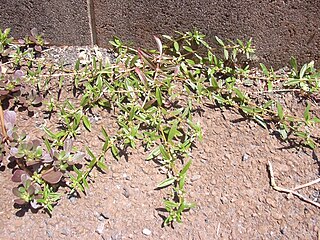
Oldenlandia is a genus of flowering plants in the family Rubiaceae. It is pantropical in distribution and has about 240 species. The type species for the genus is Oldenlandia corymbosa.

Salsola is a genus of the subfamily Salsoloideae in the family Amaranthaceae. The genus sensu stricto is distributed in central and southwestern Asia, North Africa, and the Mediterranean. A common name of various members of this genus and related genera is saltwort, for their salt tolerance. The genus name Salsola is from the Latin salsus, meaning "salty".
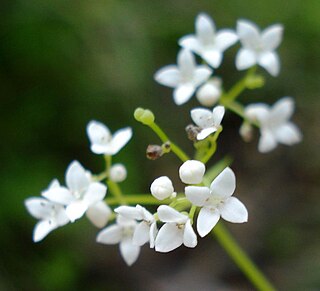
Rubieae is a tribe of flowering plants in the family Rubiaceae and contains 970 species in 15 genera. The genus Galium is responsible for more than two thirds of the species in the tribe. The second largest genus is Asperula, which contains about 200 species. Unlike the rest of the family Rubiaceae, the tribe contains predominantly perennial and annual herbs with pseudowhorls of leaves and leaflike stipules and is centered in temperate and tropical-mountain regions.

Adenocarpus is a genus of flowering plants in the family Fabaceae. It belongs to the subfamily Faboideae. The plants are broom-like shrubs with bright yellow flowers. The genus is native to the Mediterranean Basin and sub-Saharan Africa, but finds its highest diversity in Northwest Africa and the Iberian Peninsula.

Chiliadenus is a genus of flowering plants in the family Asteraceae.
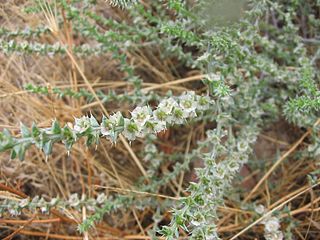
Kali is a genus of plants in the subfamily Salsoloideae in the family Amaranthaceae. Common names of various members of this genus include buckbush, rolypoly, tumbleweed for its wind-blown seed dispersal habit, and Tartar thistle and Russian thistle for its origins.
Retiniphyllum is a genus of flowering plants in the family Rubiaceae and contains 20 species. It is the only genus in the tribe Retiniphylleae. The representatives are shrubs or small trees that grow in white sand soils in tropical South America. They are mainly distributed in the Guayana Region (Venezuela) but also occur in the Amazon Basin, the eastern Andes and central and eastern Brasil.
Salvatore Brullo is professor at University of Catania since 1980 teaching Systematic Botany, he obtained a degree in natural science on July 1970. For six years he was Director of the Department of Botany, at the University of Catania.
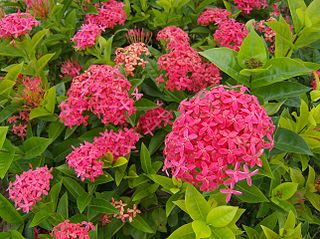
Ixoroideae is a subfamily of flowering plants in the family Rubiaceae and contains about 4000 species in 27 tribes.
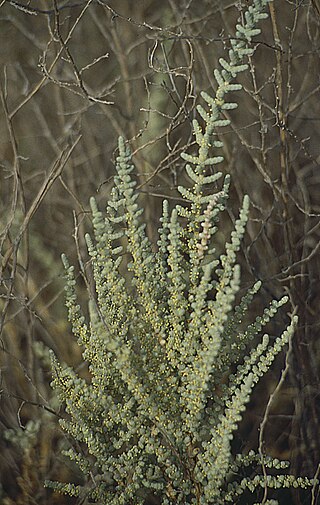
Halocnemum is a genus of halophytic shrubs in the family Amaranthaceae. The plants are fleshy and apparently articulated with characteristic globular or short-cylindrical lateral branches, and reduced leaves and flowers. There are two species, occurring from Southern Europe and North Africa to Asia.

Dr. Charlotte M. Taylor is a botanist and professor specialising in taxonomy and conservation. She works with the large plant family Rubiaceae, particularly found in the American tropics and in the tribes Palicoureeae and Psychotrieae. This plant family is an economically important group, as it includes plant species used to make coffee and quinine. Taylor also conducts work related to the floristics of Rubiaceae and morphological radiations of the group. Taylor has collected plant samples from many countries across the globe, including Chile, Colombia, Costa Rica, Panama, and the United States of America, and has named many new species known to science from these regions. As of 2015, Taylor has authored 278 land plant species' names, the seventh-highest number of such names authored by any female scientist.

Hypericum sect. Adenosepalum is one of 36 sections in the genus Hypericum. Its type species is Hypericum montanum.
















